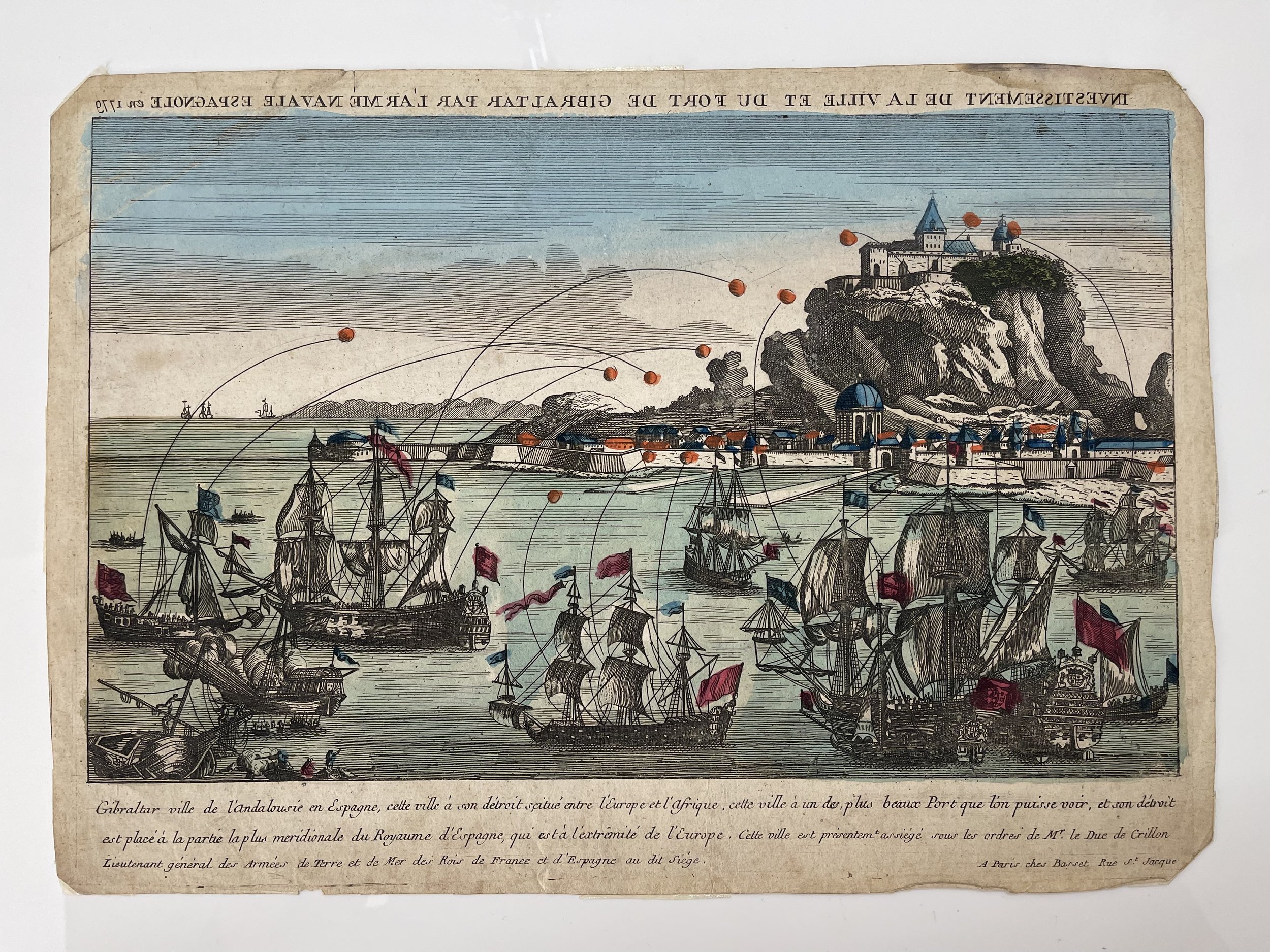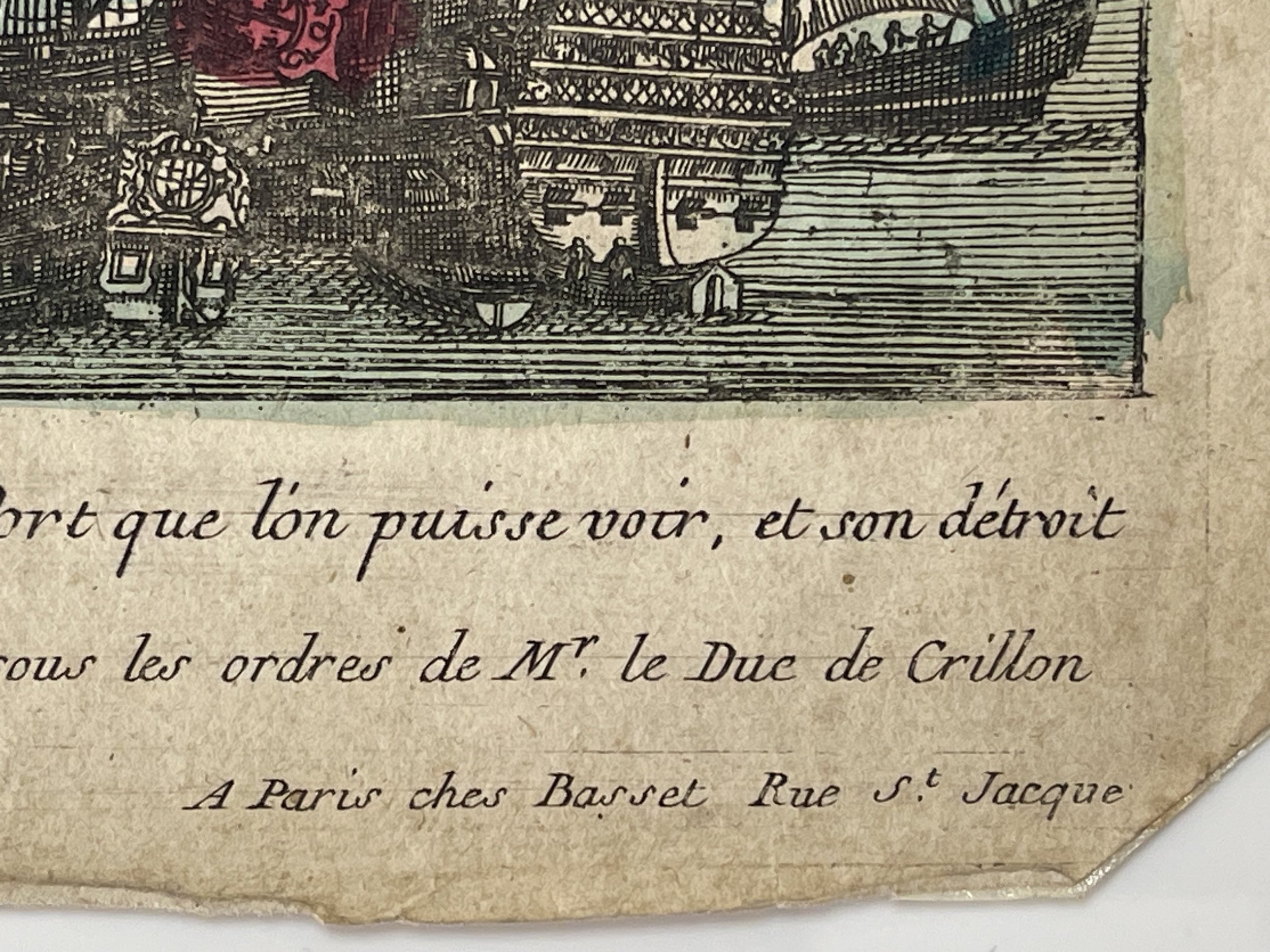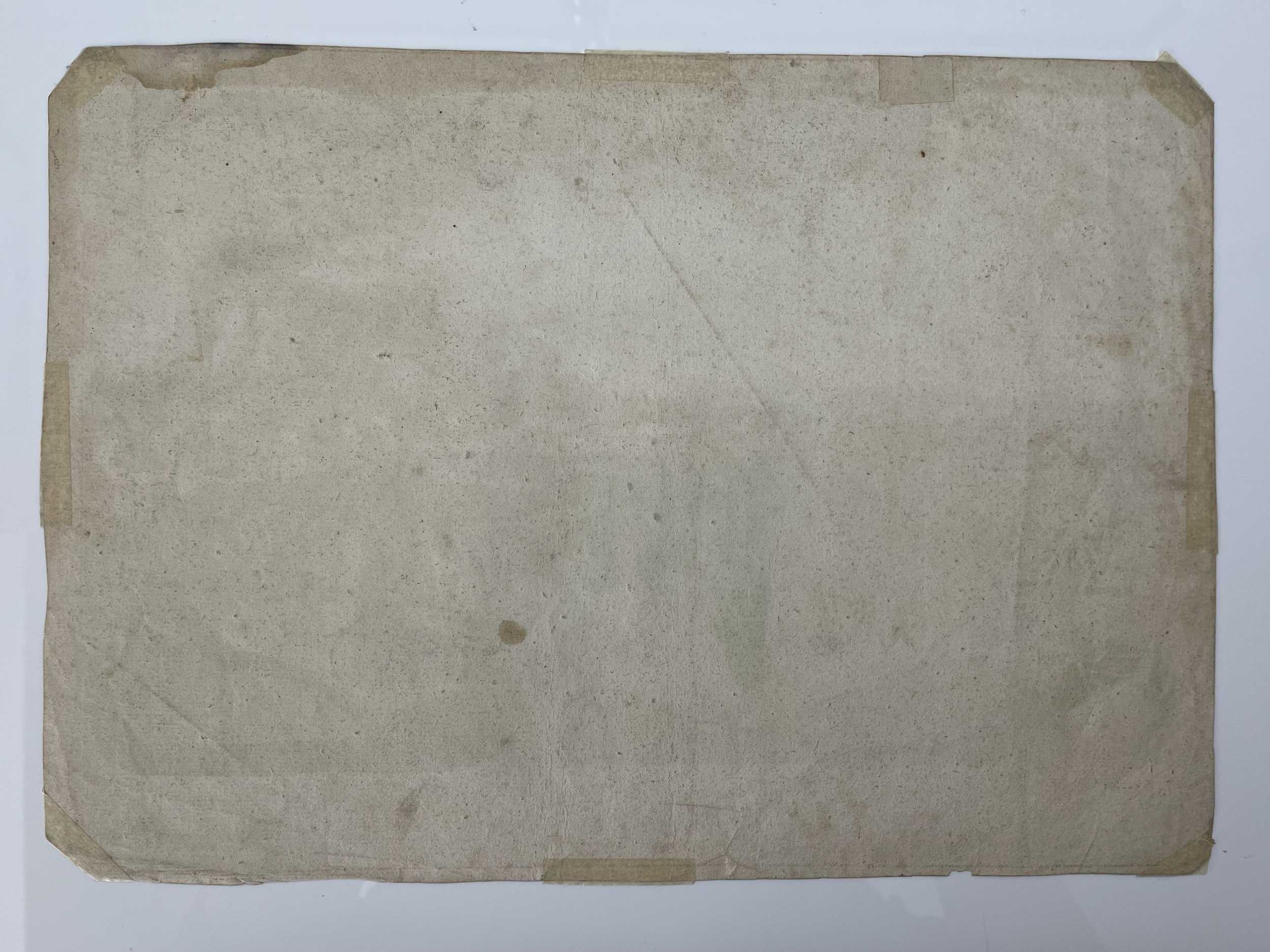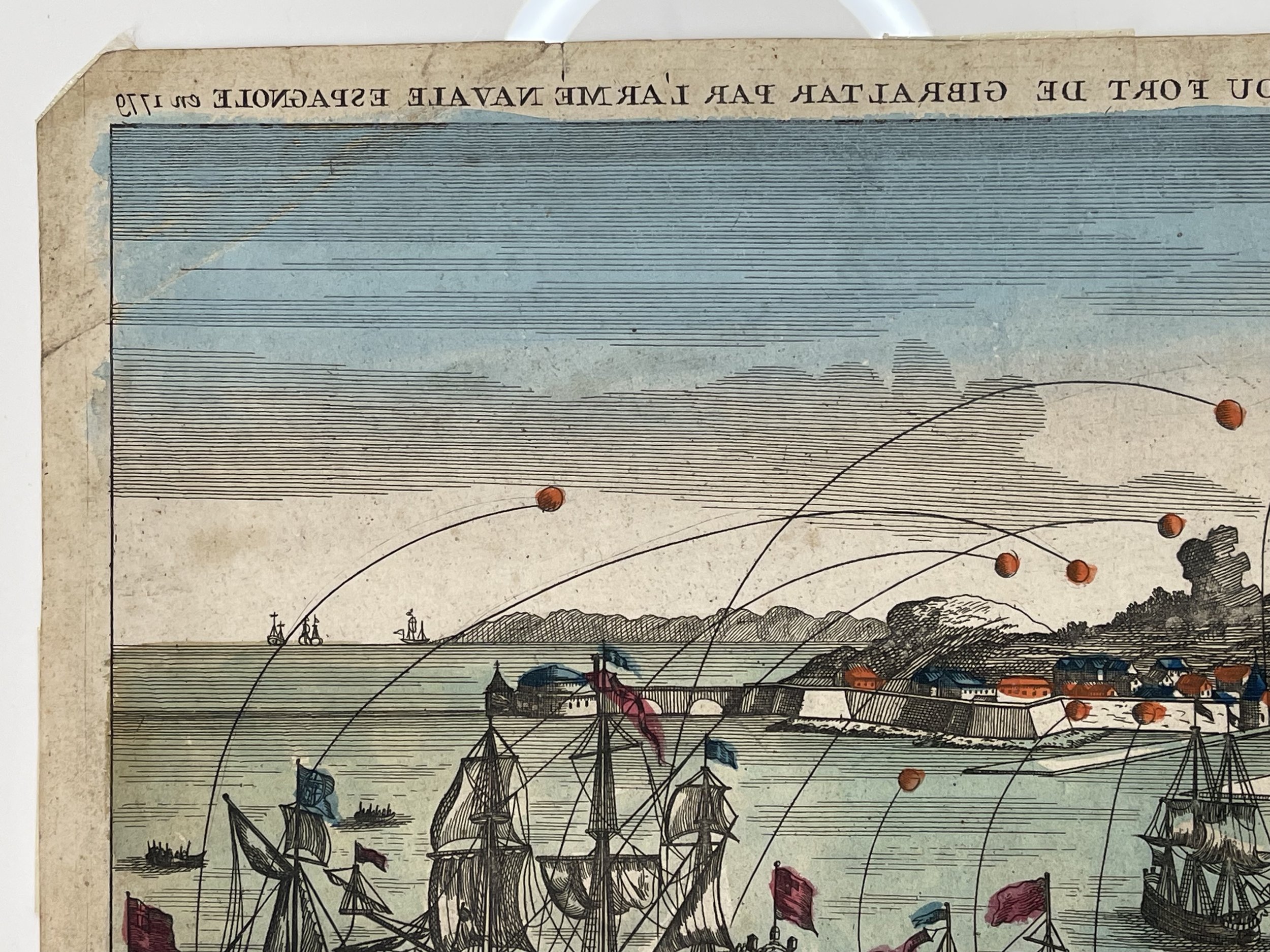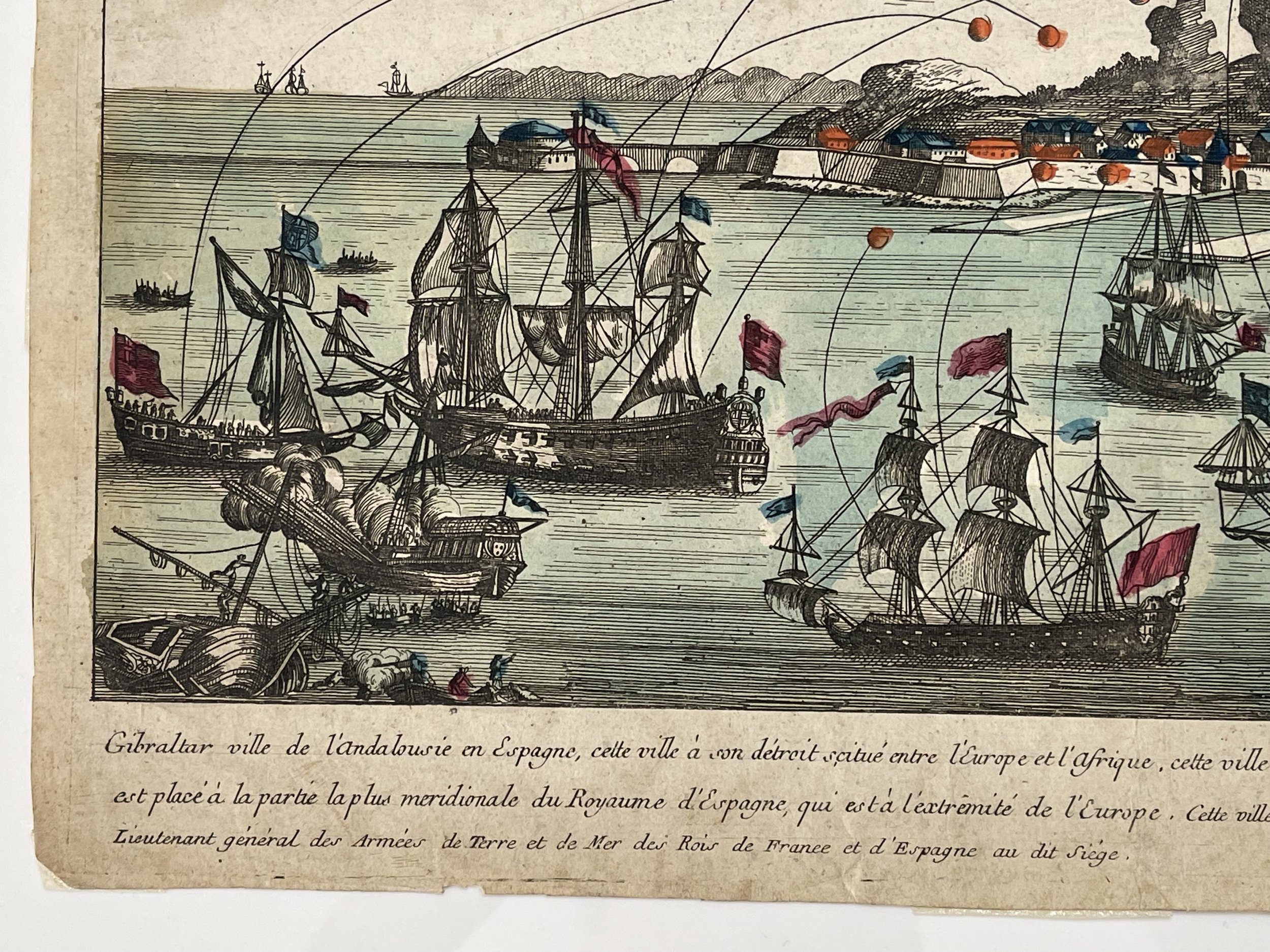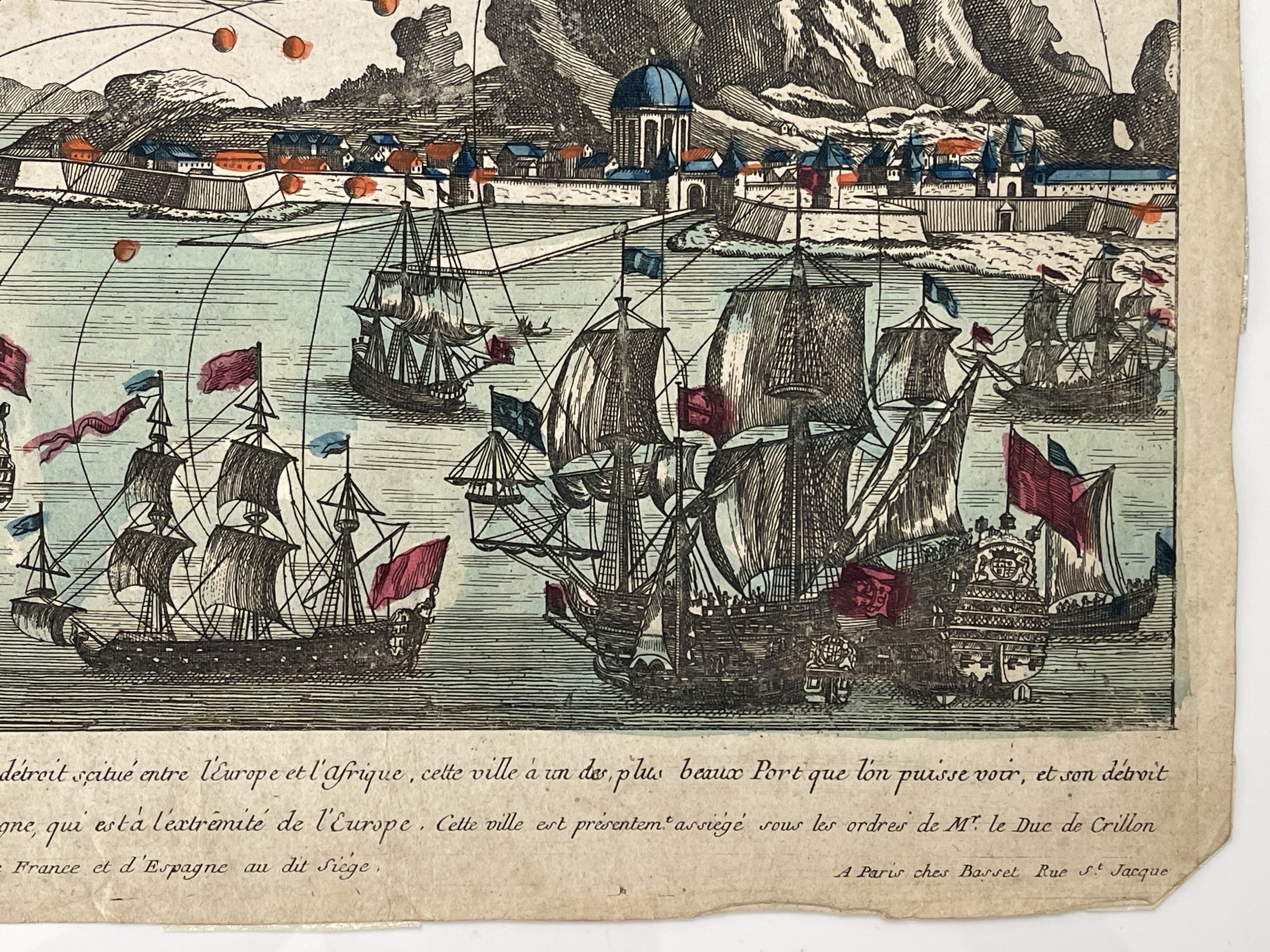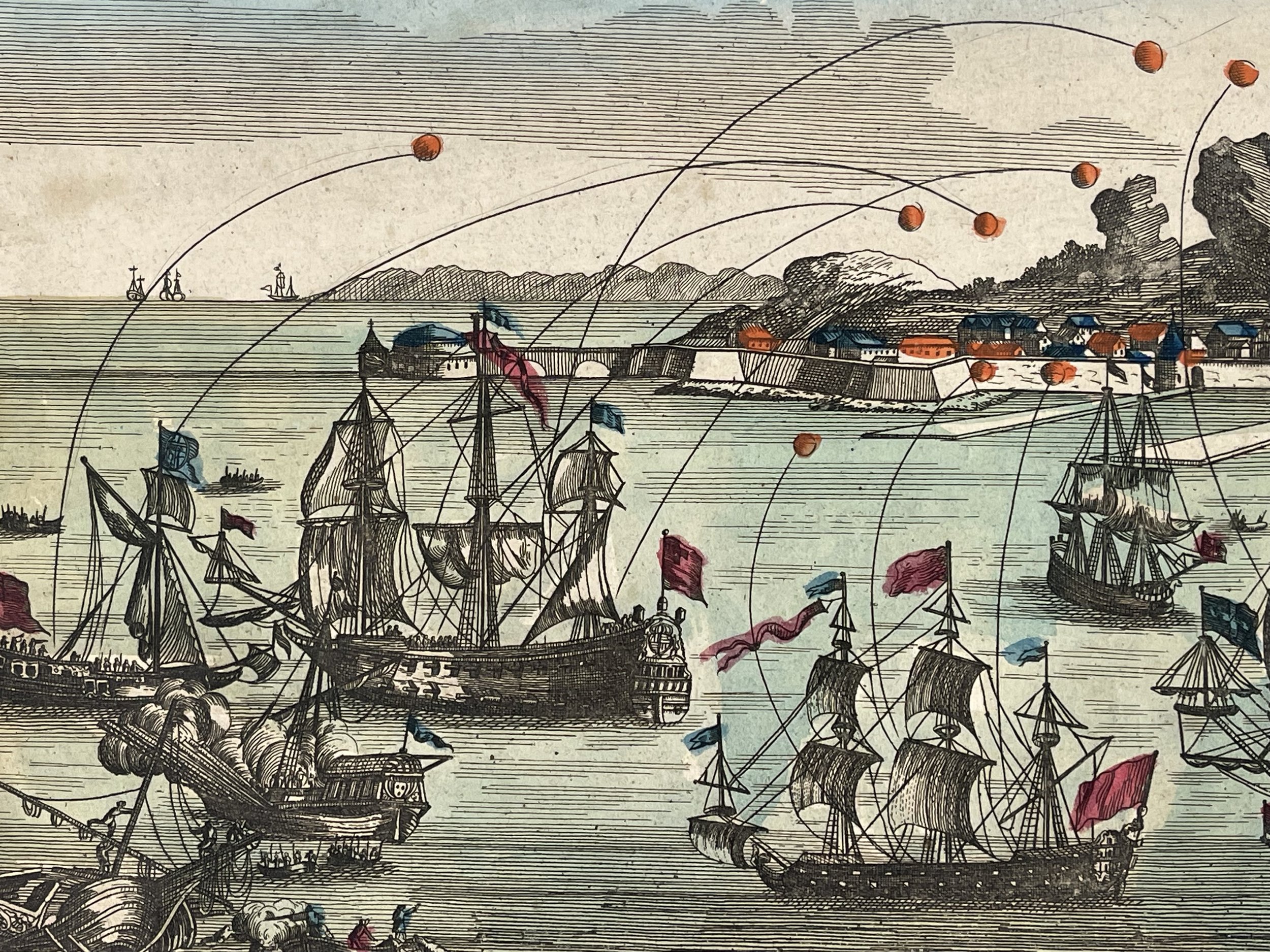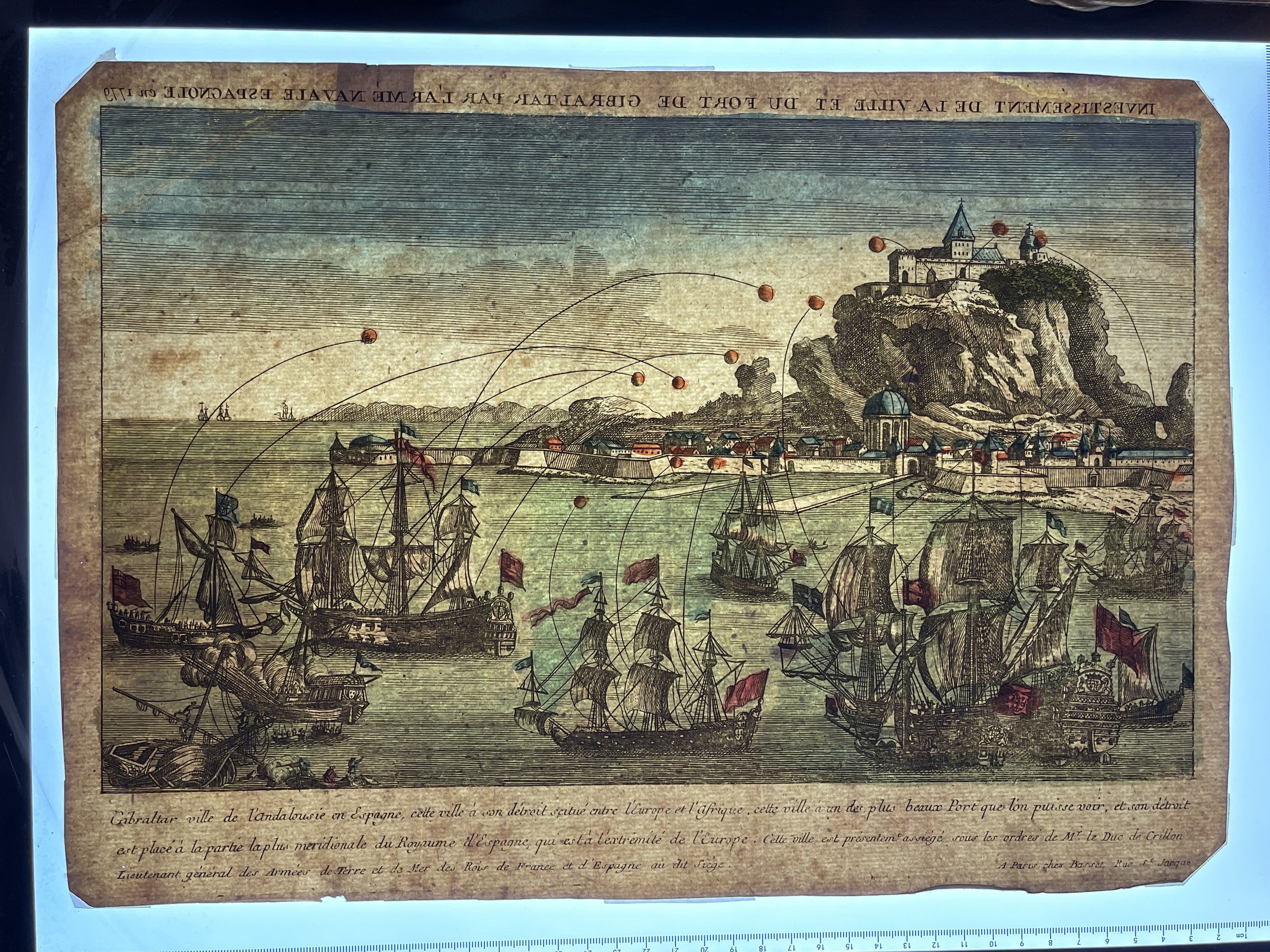The Great Siege of Gibraltar - Jacques Simon Chéreau / André Basset - 1779-1787
Gibraltar city of Andalusia in Spain, this city has its strait located between Europe and Africa. This city has one of the most beautiful Ports that one can see, and its strait is placed in the most southern part of the Kingdom of Spain, which is at the extremity of Europe. This city is presently besieged under the orders of Mr. Le Duc de Crillon Lieutenant General of the Armies of Land and Sea of the Kings of France and Spain at the said Siege. Mirrored title in the upper margin: Investment of the town and fort of Gibraltar by the Spanish naval army in 1779.
Beautiful coloured engraving of the siege of Gibraltar. Rare. - Would grace any room framed. The Title at the top is inverted, strangely common with prints of this period. Engraving will produce a printed reverse or mirror image of the image on the plate. Sometimes engravers looked at the object, usually another image such as a drawing, that they were engraving through a mirror so that the image was naturally reversed, and they would be less likely to engrave the image incorrectly..
Print publisher; son of Jacques Simon Chéreau (1732-1786) and Louise Perette Charpentier, who were married in 1760. Dates of birth and death unknown but he is reported to have married Geneviève Basset (the daughter of publisher André Basset jeune) on 27 October 1787 and to have been active until the French Empire. Lettering on a portrait of Joséphine Bonaparte indicates that he also sold wallpaper: "Il tient Magasin de Papiers en Gros en Rouleaux pour Tentures". 176?.-1805 (fl).
André Basset (1749 fl.-1787) printmaker, publisher, printer. Known as Basset le jeune, to distinguish him from his elder brother Antoine. Succeeded by his son Paul André. corner of rue Saint Jacques and of Mathurins, à l'enseigne de Sainte Geneviève, 64 rue St Jacques, Paris.
The Great Siege of Gibraltar was an unsuccessful attempt by Spain and France to capture Gibraltar from the British during the American Revolutionary War. It was the largest battle in the war by number of combatants.
On 16 June 1779, Spain entered the war on the side of France and as co-belligerents of the revolutionary United Colonies—the British base at Gibraltar was Spain's primary war aim. The vulnerable Gibraltar garrison under George Augustus Eliott was blockaded from June 1779 to February 1783, initially by the Spanish alone, led by Martín Álvarez de Sotomayor. The blockade proved to be a failure because two relief convoys entered unmolested—the first under Admiral George Rodney in 1780 and the second under Admiral George Darby in 1781—despite the presence of the Spanish fleets. The same year, a major assault was planned by the Spanish, but the Gibraltar garrison sortied in November and destroyed much of the forward batteries
After the Spanish consistently failed to either defeat the garrison or prevent the arrival of relief efforts, the besiegers were reinforced by French forces under de Crillon, who took over command in early 1782. After a lull in the siege, during which the Franco-Spanish besiegers gathered more guns, ships and troops, a "Grand Assault" was launched on 13 September 1782. This involved huge numbers—60,000 men, 49 ships of the line and 10 specially designed, newly invented floating batteries—against the 5,000 defenders. The assault proved to be a disastrous and humiliating failure, resulting in heavy losses for the Bourbon attackers. This was the largest action fought during the war in terms of numbers.
The final sign of defeat for the allies came when a crucial British relief convoy under Admiral Richard Howe slipped through the blockading fleet and arrived at the garrison in October 1782. The siege was finally lifted on 7 February 1783 and resulted in a decisive victory for the British. The siege was a factor in ending the American Revolutionary War the Peace of Paris negotiations were reliant on news from the siege, particularly at its climax.
At three years, seven months and twelve days, it is the longest siege endured by the British Armed Forces
Gibraltar city of Andalusia in Spain, this city has its strait located between Europe and Africa. This city has one of the most beautiful Ports that one can see, and its strait is placed in the most southern part of the Kingdom of Spain, which is at the extremity of Europe. This city is presently besieged under the orders of Mr. Le Duc de Crillon Lieutenant General of the Armies of Land and Sea of the Kings of France and Spain at the said Siege. Mirrored title in the upper margin: Investment of the town and fort of Gibraltar by the Spanish naval army in 1779.
Beautiful coloured engraving of the siege of Gibraltar. Rare. - Would grace any room framed. The Title at the top is inverted, strangely common with prints of this period. Engraving will produce a printed reverse or mirror image of the image on the plate. Sometimes engravers looked at the object, usually another image such as a drawing, that they were engraving through a mirror so that the image was naturally reversed, and they would be less likely to engrave the image incorrectly..
Print publisher; son of Jacques Simon Chéreau (1732-1786) and Louise Perette Charpentier, who were married in 1760. Dates of birth and death unknown but he is reported to have married Geneviève Basset (the daughter of publisher André Basset jeune) on 27 October 1787 and to have been active until the French Empire. Lettering on a portrait of Joséphine Bonaparte indicates that he also sold wallpaper: "Il tient Magasin de Papiers en Gros en Rouleaux pour Tentures". 176?.-1805 (fl).
André Basset (1749 fl.-1787) printmaker, publisher, printer. Known as Basset le jeune, to distinguish him from his elder brother Antoine. Succeeded by his son Paul André. corner of rue Saint Jacques and of Mathurins, à l'enseigne de Sainte Geneviève, 64 rue St Jacques, Paris.
The Great Siege of Gibraltar was an unsuccessful attempt by Spain and France to capture Gibraltar from the British during the American Revolutionary War. It was the largest battle in the war by number of combatants.
On 16 June 1779, Spain entered the war on the side of France and as co-belligerents of the revolutionary United Colonies—the British base at Gibraltar was Spain's primary war aim. The vulnerable Gibraltar garrison under George Augustus Eliott was blockaded from June 1779 to February 1783, initially by the Spanish alone, led by Martín Álvarez de Sotomayor. The blockade proved to be a failure because two relief convoys entered unmolested—the first under Admiral George Rodney in 1780 and the second under Admiral George Darby in 1781—despite the presence of the Spanish fleets. The same year, a major assault was planned by the Spanish, but the Gibraltar garrison sortied in November and destroyed much of the forward batteries
After the Spanish consistently failed to either defeat the garrison or prevent the arrival of relief efforts, the besiegers were reinforced by French forces under de Crillon, who took over command in early 1782. After a lull in the siege, during which the Franco-Spanish besiegers gathered more guns, ships and troops, a "Grand Assault" was launched on 13 September 1782. This involved huge numbers—60,000 men, 49 ships of the line and 10 specially designed, newly invented floating batteries—against the 5,000 defenders. The assault proved to be a disastrous and humiliating failure, resulting in heavy losses for the Bourbon attackers. This was the largest action fought during the war in terms of numbers.
The final sign of defeat for the allies came when a crucial British relief convoy under Admiral Richard Howe slipped through the blockading fleet and arrived at the garrison in October 1782. The siege was finally lifted on 7 February 1783 and resulted in a decisive victory for the British. The siege was a factor in ending the American Revolutionary War the Peace of Paris negotiations were reliant on news from the siege, particularly at its climax.
At three years, seven months and twelve days, it is the longest siege endured by the British Armed Forces
Gibraltar city of Andalusia in Spain, this city has its strait located between Europe and Africa. This city has one of the most beautiful Ports that one can see, and its strait is placed in the most southern part of the Kingdom of Spain, which is at the extremity of Europe. This city is presently besieged under the orders of Mr. Le Duc de Crillon Lieutenant General of the Armies of Land and Sea of the Kings of France and Spain at the said Siege. Mirrored title in the upper margin: Investment of the town and fort of Gibraltar by the Spanish naval army in 1779.
Beautiful coloured engraving of the siege of Gibraltar. Rare. - Would grace any room framed. The Title at the top is inverted, strangely common with prints of this period. Engraving will produce a printed reverse or mirror image of the image on the plate. Sometimes engravers looked at the object, usually another image such as a drawing, that they were engraving through a mirror so that the image was naturally reversed, and they would be less likely to engrave the image incorrectly..
Print publisher; son of Jacques Simon Chéreau (1732-1786) and Louise Perette Charpentier, who were married in 1760. Dates of birth and death unknown but he is reported to have married Geneviève Basset (the daughter of publisher André Basset jeune) on 27 October 1787 and to have been active until the French Empire. Lettering on a portrait of Joséphine Bonaparte indicates that he also sold wallpaper: "Il tient Magasin de Papiers en Gros en Rouleaux pour Tentures". 176?.-1805 (fl).
André Basset (1749 fl.-1787) printmaker, publisher, printer. Known as Basset le jeune, to distinguish him from his elder brother Antoine. Succeeded by his son Paul André. corner of rue Saint Jacques and of Mathurins, à l'enseigne de Sainte Geneviève, 64 rue St Jacques, Paris.
The Great Siege of Gibraltar was an unsuccessful attempt by Spain and France to capture Gibraltar from the British during the American Revolutionary War. It was the largest battle in the war by number of combatants.
On 16 June 1779, Spain entered the war on the side of France and as co-belligerents of the revolutionary United Colonies—the British base at Gibraltar was Spain's primary war aim. The vulnerable Gibraltar garrison under George Augustus Eliott was blockaded from June 1779 to February 1783, initially by the Spanish alone, led by Martín Álvarez de Sotomayor. The blockade proved to be a failure because two relief convoys entered unmolested—the first under Admiral George Rodney in 1780 and the second under Admiral George Darby in 1781—despite the presence of the Spanish fleets. The same year, a major assault was planned by the Spanish, but the Gibraltar garrison sortied in November and destroyed much of the forward batteries
After the Spanish consistently failed to either defeat the garrison or prevent the arrival of relief efforts, the besiegers were reinforced by French forces under de Crillon, who took over command in early 1782. After a lull in the siege, during which the Franco-Spanish besiegers gathered more guns, ships and troops, a "Grand Assault" was launched on 13 September 1782. This involved huge numbers—60,000 men, 49 ships of the line and 10 specially designed, newly invented floating batteries—against the 5,000 defenders. The assault proved to be a disastrous and humiliating failure, resulting in heavy losses for the Bourbon attackers. This was the largest action fought during the war in terms of numbers.
The final sign of defeat for the allies came when a crucial British relief convoy under Admiral Richard Howe slipped through the blockading fleet and arrived at the garrison in October 1782. The siege was finally lifted on 7 February 1783 and resulted in a decisive victory for the British. The siege was a factor in ending the American Revolutionary War the Peace of Paris negotiations were reliant on news from the siege, particularly at its climax.
At three years, seven months and twelve days, it is the longest siege endured by the British Armed Forces
Code : A1050
Cartographer : Cartographer / Engraver / Publisher: Jacques Simon Chéreau / André Basset
Date : Publication Place / Date - Circa 1779-1787
Size : Sheet size: Image Size: 39 x 28 cm
Availability : Available
Type - Genuine - Antique
Grading A
Where Applicable - Folds as issued. Light box photo shows the folio leaf centre margin hinge ‘glue’, this is not visible otherwise.
Tracked postage, in casement. Please contact me for postal quotation outside of the UK.
